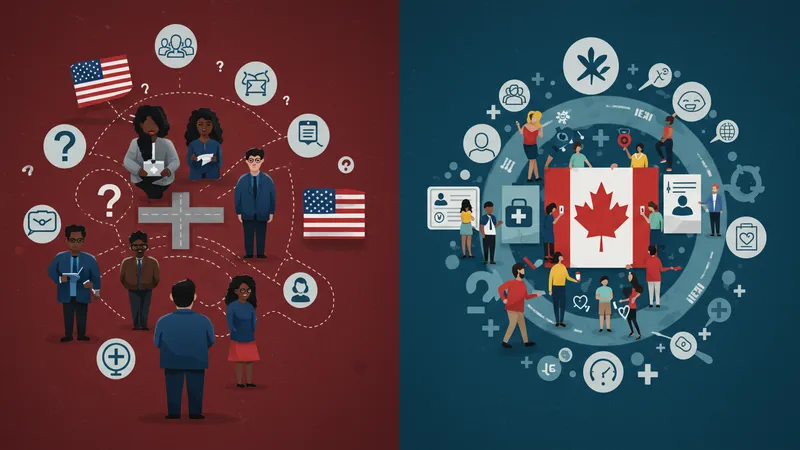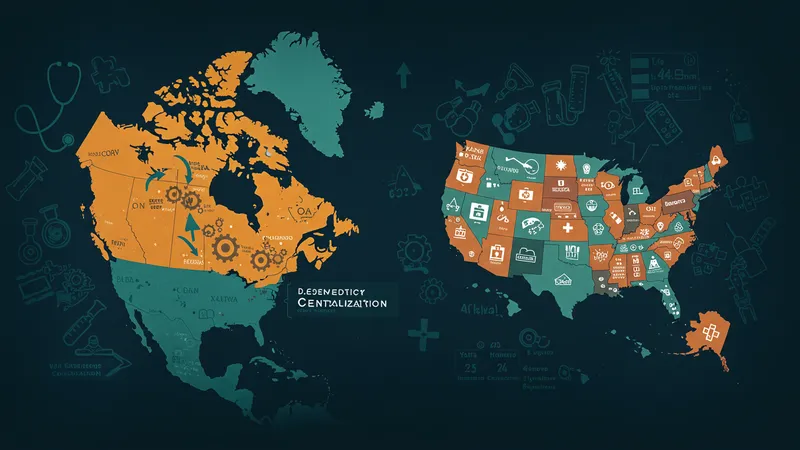Did you know that while health insurance in the USA might leave holes in your wallet, Canadians enjoy the benefits of a largely government-funded healthcare system? This fundamental difference impacts millions and shapes the healthcare landscape of North America.
With recent policy changes and health challenges globally, understanding these differences is more crucial than ever. A deeper dive sheds light on what both systems can learn from each other.

Here’s something shocking: while US citizens often land in debt due to medical expenses, Canadians typically wait longer for certain procedures. But that’s not even the wildest part—despite the wait, satisfaction rates in Canada are surprisingly high. Could it be due to the financial peace of mind? Or is there something else at play?
Another twist is the administrative costs. The USA spends billions more on healthcare administration compared to Canada. This bloated bureaucracy, many argue, leads to inflated prices and inefficiencies. But what if there was a more streamlined approach hiding in plain sight? What happens next shocked even the experts…
In the United States, health insurance costs can vary drastically depending on your employment, age, and location. With premiums that sometimes reach over $500 a month, many Americans struggle to afford proper coverage. Yet, there's a puzzling irony: despite paying more, Americans don't necessarily receive better healthcare outcomes compared to Canadians.

In Canada, the majority of healthcare expenses are covered through taxes, leaving residents to worry less about financial implications. However, what remains hidden from popular discourse is how Canadians still face significant out-of-pocket expenses for things like dental care and prescription drugs, which are not fully covered by their government plans.
It's crucial to recognize that a considerable chunk of American healthcare dollars goes towards administrative costs. This massive overhead could potentially be reduced by adopting strategies observed in Canada. But there's a twist—what if these differences aren't just about administrative decisions?
What truly distinguishes these systems is how societal values shape them. Americans often link success with private, choice-based healthcare, while Canadians see universal health coverage as a fundamental right. What you read next might change how you perceive these differences forever.
In healthcare, an intense debate rages about the merits of private versus public funding. The USA leans heavily on private insurance models, making personal choice a key driver behind healthcare decisions. Yet this freedom comes with the burden of high premiums and deductibles, which can lead to extreme financial stress.

Canada's healthcare model, largely publicly funded, symbolizes a belief in equal access. This system, however, isn't without its critics. Some argue that long wait times for certain procedures compromise the quality of care. Yet, surprisingly, many Canadians prioritize equitable access over individual convenience.
Beyond uninsured rates, another stark contrast is in the financial risks faced by Americans without employer-backed insurance. These individuals might find themselves spending an unimaginable proportion of their income on healthcare, whereas Canadians perceive healthcare as a universal right, regardless of employment status.
The real question is: which system provides actual peace of mind? Could one nation learn from the other's failings? And what would happen if these differences were reconciled? Keep reading for answers that challenge conventional wisdom.
Government involvement in healthcare is a hot-button issue. In the USA, national debates center around the role of Medicare and Medicaid, with many concerned about potential overreach. Meanwhile, Canada embraces government involvement as a cornerstone of its health policy, but there's an underlying concern about the system's sustainability.

Despite these differences, both countries face similar challenges in dealing with aging populations and the rising costs of innovative medical technologies. What Canada excels in, however, is leveraging data-driven efficiency, something the USA might adapt to reduce costs without sacrificing quality.
For instance, while Americans worry about losing coverage with job changes, Canadians enjoy a seamless healthcare experience thanks to portable insurance. Could this be the blueprint for reforming American policies? The answers might surprise you.
Ultimately, it's about finding balance, but there's one more twist—when faced with the reality of shrinking budgets and a general demand for better care, will either country be prepared to make the tough, yet potentially transformative choices necessary?
Though both nations are at the forefront of medical research and innovation, how they translate advances into healthcare outcomes is telling. Americans often expect the best technology and specialists, sometimes without considering the steep costs involved. Meanwhile, Canadians tend to focus on overall health and prevention.

But did you know that Canada's emphasis on preventive care reduces hospital visits? This investment in long-term well-being might just be a key factor in improving overall health outcomes, as opposed to the reactionary nature of many American health solutions.
One surprising statistic is how life expectancy and infant mortality rates in Canada often surpass those in the USA. These metrics tell a broader story of how healthcare systems impact everyday lives beyond just dollars and cents—could this reflect a more compassionate model of care?
As you ponder these systems, an intriguing question arises: what if blending the best elements of each could redefine North American health for the better? But before we speculate, let's explore more about underlying social dynamics that could hold the answers.
Delving into cultural perceptions, it's clear that societal beliefs deeply influence healthcare preferences across borders. Americans highly value personal choice, offering a wide array of healthcare options, whereas Canadians often prioritize collective well-being.

In America, healthcare is also tied to freedom and individualism, often reflecting one's status or employer benefits, unlike in Canada, where inclusivity and welfare are central. This cultural outlook suggests why Canadians are generally more satisfied with their level of care despite longer wait times.
Yet, stunningly, when confronted with serious illness, evidence shows that satisfaction among patients in both countries levels out, indicating universal human experiences beyond cultural narratives. Could it be that, at the core, people merely desire reliable care when they need it most?
This dual perspective challenges the notion that more choice equals better outcomes. As we dive deeper, another dimension surfaces—how technology reshapes these perceptions and could erode old paradigms. The implications could flip the script on conventional healthcare models.
No longer can we ignore the technological revolution transforming global healthcare landscapes. From telemedicine to AI diagnostics, both the USA and Canada are rapidly integrating technology to provide better services and outcomes.

While both countries embrace digital innovation, the access gap widens. In the USA, the tech boom has been most advantageous to those who can afford it, deepening inequality. Conversely, Canada's strategic rollout prioritizes national coverage, attempting to democratize access.
Consider Maple, Canada's telehealth platform, bridging long wait times and geographic distances. Meanwhile, American systems like Zocdoc offer seamless appointment scheduling, albeit often limited by insurance coverage. This tech disparity calls into question whether advancements are adequately leveraged for widespread benefit.
At the intersection of healthcare and technology, there's an undeniable potential to close gaps in accessibility and care. As we unravel these challenges, remember the question of how digital health collaborations might change everything you've come to accept about medical systems.
Looking ahead, both countries are at a healthcare crossroads, confronting common challenges that require innovative solutions. Regulatory frameworks and political will are essential to transforming these systems in a way that benefits all citizens, irrespective of geography.

The potential for cross-border collaboration becomes intriguing, especially in areas like drug pricing negotiations and clinical trial participation. This joint effort could lead to more affordable medications and breakthrough therapies. But will these initiatives gain traction?
Current policy debates suggest that future healthcare strategies might not remain confined within borders. Learning from one another, exchanging best practices, and jointly tackling formidable health issues could pave the way for a new healthcare paradigm.
As reforms loom, the ultimate test lies in political and public resolve. Will North America rise to the challenge by merging strengths and leaving traditional hurdles behind? Picture a future where healthcare crises see decisive, informed actions based on comprehensive understanding and unity.
The pandemic revealed stark contrasts in how the USA and Canada manage healthcare crises. Each system showed strengths and vulnerabilities, offering invaluable lessons on preparedness and response strategies.

Canada's centralized approach enabled swift policy shifts and resource allocation, but was hampered by logistical hurdles. The decentralized American system, in contrast, meant varied regional responses, highlighting flexibility but also inconsistency.
This stark difference points toward a need for balanced strategies that combine agility and uniformity. Could it be that beyond crises, these lessons could reshape daily healthcare operations?
While solutions are far from simple, fostering dialogue between these nations could catalyze shared understanding, incentivizing innovation and efficient practice. As we ponder this potential, we approach the final pages of insights that question longstanding beliefs.
The debate whether healthcare is a privilege or a right remains at the forefront. The Canadian model largely upholds healthcare as a fundamental right, supported by public consensus and policies. This stands in contrast to the USA's ongoing ideological divide.

Americans grapple with the idea of universal healthcare versus the implications of government mandates. Could embracing healthcare as a human right, akin to education, lead to more sustainable reform? The implications are enormous.
Shifting focus from economic burden to human dignity, programs tailored to the needs of vulnerable groups might emerge. As political landscapes evolve, so too does the conversation surrounding rights and obligations.
Going beyond rhetoric, the vision of equitable healthcare requires societal shifts and global collaboration. It's a future that challenges norms, invoking reflection about the kind of societies we strive to create. Let's turn the page to consider the broader implications.
Imagine every choice, from policy to personal health decisions, intertwined with intricate consequences often overlooked. The ripple effects of healthcare policies stretch beyond mere access and affordability.

Jobs, economic growth, and even educational outcomes in both countries correlate with health system stability. As such, a stronger emphasis on health literacy could fuel incredible societal advances, sparking a positive feedback loop.
This interconnectedness suggests that focusing solely on healthcare misses out on broader dialogues about well-being—a factor pivotal to pioneering holistic reforms. Could there be an unforeseen upside to these decades-long debates, perhaps even uniting other sectors?
With this realization, these dialogues around healthcare might transform into the catalyst for unprecedented improvement across continents. It's nearing time for a dramatic conclusion, but what lessons might we carry forward? Let's find out.
Envision a world where the USA and Canada leverage shared insights and innovations, crafting healthcare systems that prioritize humanity over politics. Such collaboration doesn't only signify healing, but thriving on a global stage where impacted lives define success.

By embracing variations in systems and focusing on mutually beneficial strategies, progress feels inevitable. The path forward is not solitary but shared, inviting creativity and courage to tackle even the most formidable health dilemmas.
As we transition from competition to cooperation, every dialog holds potential to rewrite healthcare's future. Will we seize this opportunity for radical compassion, reshaping the health narrative for all?
The tale of two nations becomes a shared story of dedication, resilience, and hope, driven by an intertwined quest for justice and advancement. As we conclude this journey, a final twist awaits—what transformative action will you take today?
The ultimate takeaway is clear: health insurance in the USA and Canada teaches valuable lessons about priorities, people, and systems. By sharing this article, you spark a conversation that transcends borders, inspiring action towards reform. Let this be the start of an impactful journey, where compassionate collaboration unveils limitless possibilities.